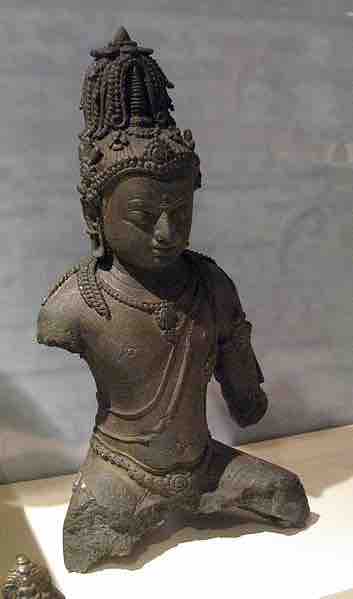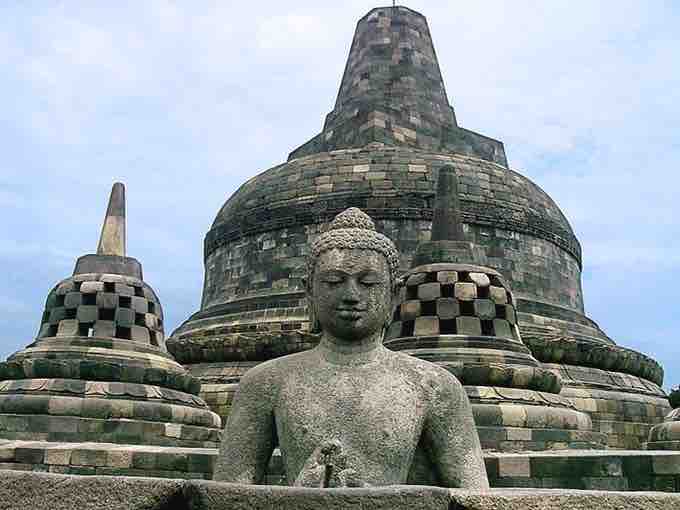Overview: Indonesia
The culture and art of Indonesia has been shaped by interaction between local indigenous customs and multiple foreign influences. Situated on the ancient maritime trading routes between the Near East and the Far East, Indonesia was exposed to a multitude of foreign cultural practices and religions, including Hinduism, Buddhism, and Islam. The result is a complex fusion of many different customs, expressed in Indian art forms.
Architecture in Indonesia before 1200 CE
The Sri Vijaya Empire
Indonesia has a particularly rich tradition of Hindu–Buddhist sculpture and architecture, which was strongly influenced by India from the 1st century CE onward. The earliest Buddhist structures in Indonesia to survive to the present day are the 4th century Batujaya plastered brick stupas in West Java. However, Buddhist art reached its golden era under the Sailendra dynasty of the Sri Vijaya Empire. The islands of Sumatra and Java in western Indonesia were the seat of the Sri Vijaya Empire (8th–13th centuries), which practiced Mahayana and Vajrayana Buddhism and were a major political and cultural influence in the Southeast Asian peninsula.

Bronze Maitreya statue, South Sumatra, Indonesia, c. 9th–10th century.
This bronze Bodhisattva Maitreya is an example of Sri Vijayan sculpture. The statue's distinctive crown incorporates a stupa in its design.
Stone and bronze sculpture flourished between the 8th and 10th century CE under the Sailendra dynasty in Java and Bali. These sculptures were either free-standing statues or relief sculptures and friezes incorporated into temples; they are characterized by their delicacy and serenity of expression.
Borobudur
The most outstanding example of this classical Hindu–Buddhist sculpture in Indonesia is found in the temple of Borobudur in central Java. Built in the 8th century, Borobudur is the largest Buddhist temple in the world and is supposed to represent a map of the Buddhist cosmos; it is a masterful combination of didactic narrative sculptures, spiritual symbolism, monumental design, and meditative serenity. The entire structure resembles a stupa, and when seen from above, looks like a mandala, a concentric diagram with spiritual significance in Buddhism. As part of its structure, it has 504 statues of the Buddha and 2,672 relief panels depicting the life of the Buddha. As a visitor ascends through the eight levels of the temple, the story unfolds from beginning to end. The last three levels simply contain stupas and statues of the Buddha.

Borobudur's main stupa, Java, Indonesia.
This image shows the main Stupa crowning the Borobudur, built in the 8th century by the Sailendra dynasty. The uppermost terrace has rows of bell-shaped stupas and Buddha images. The main stupa itself is empty, symbolizing perfect enlightenment.
Prambanan
Near Borobudur is the 9th century temple complex of Prambanan, one of the oldest and largest Hindu temples in Southeast Asia. The complex consists of eight main shrines, surrounded by 224 smaller ones. The Indian influence on the building is unmistakable, not only in the architectural style but also in the stone reliefs featuring scenes from the Hindu epic Ramayana, which adorn the outer walls of the main temples.
Architecture in Indonesia after 1200 CE
The Majapahit Empire
The decline of the Sri Vijaya Empire in the 11th century was accompanied by a corresponding decline in Buddhism and a shift of power to Eastern Java. The Majapahit Empire was established in 1293 and lasted until around 1500. The Majapahit rulers practiced a mix of Hinduism, Buddhism, and animism, and the religious architecture reflects this synthesis. Indonesian art enjoyed a golden age under Majapahit rule, and an enormous number of Hindu–Buddhist temples, or candi, were built during this period. The building material of choice was brick and mortar of vine sap and palm sugar. Majapahit architecture is characterized by tall and slender roofed red brick gates, a strong geometrical quality, and a sense of verticality, achieved through numerous horizontal lines. Majapahit influence can still be seen to the present day in Hindu temples in Bali.
Introduction of Islam
By the 15th century, Islam had become the dominant religion in Java and Sumatra, Indonesia's most populous islands. Islamic cultural and artistic influences were absorbed and reinterpreted in the local landscape, resulting in mosques that reflected both Indonesian and Islamic background, with additional influences from Hindu, Buddhist, and Chinese architecture. Indonesian mosques lacked the ubiquitous Islamic dome until the 19th century, and they had tall timber tiered roofs similar to the pagodas of Balinese Hindu temples.